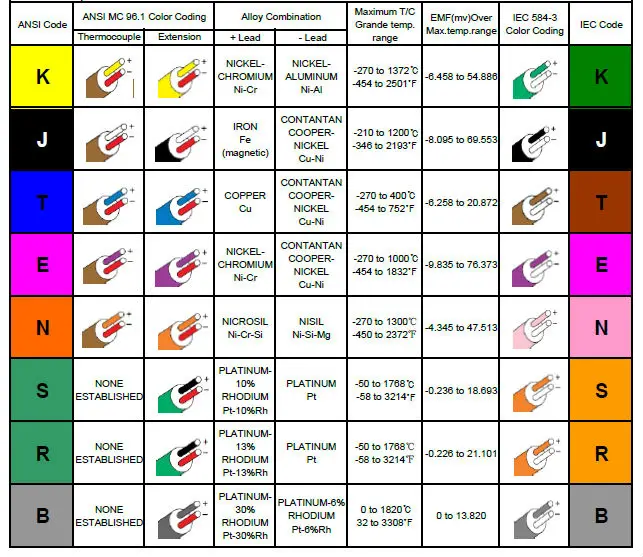1.
What instruments are use to measure temperature?
Thermometer, Bi-metallic temperature indicator, Thermo-couples, Resistance Temperature Detectors, Optical Pyrometers.
2.
What is standard temperature measuring unit in OIL&GAS industries?
Commonly using the SI unit Deg C & deg F ( Centigrade & Fahrenheit) for measuring temperature
3.
Write the Fahrenheit to Centigrade temperature conversion
formula?
Deg C = ( Deg F – 32 ) / 1.8
4.
What is the difference between ‘Centigrade’ and ‘Celsius’?
It is one and the same. Celsius is the technical name. In simple words Centigrade is a scale graduated in hundred.
5.
What is a thermo-couple? How does it work?
Two dissimilar metals are welded (joined) at one end to form a ‘hot junction’ and the other end to form a ‘cold junction’. When there is a temperature difference between the ‘hot’ and ‘cold’ junction a mv is produced in the loop proportional to the temperature difference. The amount mv production by a thermo-couple depends on the characteristic and type of thermocouple like ‘j’ , ‘k’ type etc.
6.
What are the measuring ranges of different thermocouple?

7.
What is the name commonly used thermocouples in these areas?
On Pump’s bearings: Iron constantan (J)
ON Gas Turbine’s
combustion chanmbers: Chromel
Alumel (k)
8.
what is the name of the cable used to connect a
thermocouple to a measuring instrument?
The intermediate cable used for connecting a thermocouple from the field to the control room instrument is called a ‘compensating cable’.
9.
What is ;’cold junction compensation’?
‘Cold Junction Compensation’ is used in temperature measurement by means of a thermocouple. This compensation is to correct the error caused by the room (ambient) temperature. The mv produced by a thermocouple is proportional to the temperature difference between its ‘hot’ and ‘ Cold’ junction. The cold junction is the ambient temperature (control room). Without ‘cold junction compensation’ the temperature at the hot junction will measure inaccurately.
10.
What is an RTD? How does it work?
RDT – Resistance Temperature Detector
RTD is a positive
temperature coefficient resistance which provides a linear rise in its
resistance verses the rise in temperature.
11.
What is the commonly used RTD in industries?
Pt 100 platinum resistance 100 Ohms
12. What is ‘pt 100’?
What is the resistance (in ohms) of a pt100 at 0 Deg C?
Pt 100 Platinum resistance which offers 100 ohms at 0 Deg C.
13.
What are the advantages and disadvantages of an RTD over a
thermocouple?
RTDs are accurate at a lower range of temperature measurement such as -200 Deg C to +200 Deg C.
RTDs are expensive
compared to Thermocouples, also there are limitations in measuring at the
higher range of temperature.
14.
Why does RTD measurement use 3 wires for a field signal
connection?
3 wire system is used in temperature measurement by an RTD to compensate the line resistance. Three wire system provides a Wheatstone Bridge in the measuring instrument.
15.
What is a ‘bi metallic’ temperature instrument? How does it
work? Give an example?
In a bi metallic
temperature instrument, two metals with different temperature coefficient of
expansion are attached together. Due to its expansion characteristics the
higher coefficient of expansion responds more than the lower one and a twist on
the element is formed. This principle is ;used in designing temperature
measuring instrument for the lower range.
Other than the filled
type instruments, most of the temperature indicators are of the bimetallic
types.
16.
What is a ‘filled type’ temperature instrument? Give an
example?
Principle of change in the liquid expansion with the change in temperature is used in designing the ‘filled type’ temperature measuring instrument.
For example : The glass
thermometers, filled type capillary temperature dial indicators and switches.
Filled type temperature
measuring instruments are used for lower range temperature measurement.
17.How to identify RTD & Thermocouple in the field?
Thermocouple when senses gives "mv" readings to the transmitter. RTD gives "ohm" readings to the transmitter.
For checking put the multi-meter in resistance mode
and if the the sensor is thermocouple the meter will
indicate almost"0" resistance, whereas the RTD
would indicate
around "119 ohms" in normal temperature
like 30 deg C.
18. What is mean by Ambient Temperature?
ambient temperature is the air temperature of any environment where computers and related equipment are kept. The adjectiveambient means "relating to the immediate surroundings."
ambient temperature is the air temperature of any environment where computers and related equipment are kept. The adjectiveambient means "relating to the immediate surroundings."
Great Blog,Thanks for sharing such beautiful information with us. I hope to will share some more information about electrical safety analyzer. Please visit our website electrical safety analyzer
ReplyDelete